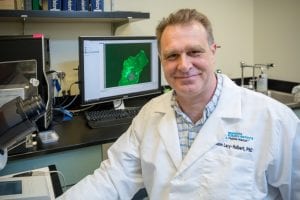Adam Lacy-Hulbert, Ph.D.

ASSOCIATE MEMBER, BENAROYA RESEARCH INSTITUTE
AFFILIATE ASSOCIATE PROFESSOR, IMMUNOLOGY
Dr. Lacy-Hulbert received his BA degree in Natural Sciences (Biochemistry) and PhD in Biochemistry from the University of Cambridge. He trained as a postdoctoral fellow at University College London, and then moved to the University of Edinburgh, as a UK Research Council Fellow. Dr. Lacy-Hulbert spent 2003 to 2007 as a visiting scientist and then visiting professor at the Center for Cancer Research at Massachusetts Institute of Technology. In 2007, Dr. Lacy-Hulbert joined the Department of Pediatrics at Massachusetts General Hospital, as Assistant Professor at Harvard Medical School and Director of the Developmental Immunology Program. Dr. Lacy-Hulbert moved his laboratory to the Benaroya Research Institute in 2013.
CONTACT INFOBenaroya Research Institute |
RESEARCH AREASTolerance & Autoimmunity LAB MEMBERSStaff Scientists Postdoctoral Fellows Laboratory Staff |
LABPUBMED |
RESEARCH
The overall research objectives of the Lacy-Hulbert Laboratory are to understand the mechanisms by which innate immune cells, such as macrophages and dendritic cells, regulate immunity and tolerance. The laboratory team uses a range of molecular and cell biology approaches, in isolated cells and whole organisms, to approach these important problems. The group has a longstanding interest in how the recognition of dying cells promotes immune tolerance and tissue repair, and the role of a specific family of cell adhesion molecules, the alpha-v Integrins, in this process. A major focus of the laboratory is how breakdown of these mechanisms can lead to inflammatory bowel disease (IBD) and autoimmunity.
In a joint program with Dr Lynda Stuart, MD, PhD, and her group, the laboratory also works to discover new mechanisms by which cells recognize and resist infection
PUBLICATIONS
- Lacy-Hulbert, A., Smith, A.M., Tissire, H., Barry, M., Crowley, D., Bronson, R.T., Roes, J.T., Savill, J.S. and Hynes, R.O. (2007) “Ulcerative colitis and autoimmunity induced by loss of myeloid av integrins”, Proceedings of the National Academy of Sciences, USA. 104:15823-15828
- Acharya, M., Mukhopadhyay, S., Paidassi, H., Jamil, T., Chow, C., Kissler, S., Stuart, L.M., Hynes, R.O. and Lacy-Hulbert, A. (2010) “Alpha(v) integrin expression by DCs is required for Th17 cell differentiation and development of experimental autoimmune encephalomyelitis in mice.” Journal of Clinical Investigation, 120: 4445-52
- Paidassi, H., Acharya, M., Zhang, A., Mukhopadhyay, S., Kwon, M., T., Chow, C., Stuart, L.M., Savill, J. and Lacy-Hulbert, A. (2011) “Preferential expression of integrin avb8 promotes generation of regulatory T cells by mouse CD103+ Dendritic Cells” Gastroenterology 141: 1813-20
- Perez, B., Paquette, N., Paidassi, H., Zhai, B., White, K., Svirsky, R., Lacy-Hulbert, A. and Stuart, L.M. (2012) “Apoptotic cells can deliver chemotherapeutics to engulfing macrophages and suppress inflammatory cytokine production.” Journal of Biological Chemistry, 287: 16029-36
- Chen, L., Stuart, L.M., Ohsumi, T.K., Burgess, S., Varshney, G.K., Dastur, A., Borowsky, M., Benes, C., Lacy-Hulbert, A.* and Schmidt, E.V.* (2013) “Transposon activation mutagenesis as a screening tool for identifying resistance to cancer therapeutics” BMC Cancer 13: 93.
- Sokolovska A, Becker CE, Ip WK, Rathinam VA, Brudner M, Paquette N, Tanne A, Vanaja SK, Moore KJ, Fitzgerald KA, Lacy-Hulbert A and Stuart LM. (2013) “Activation of caspase-1 by the NLRP3 inflammasome regulates the NADPH oxidase NOX2 to control phagosome function.” Nat. Immunol 14: 543-53.